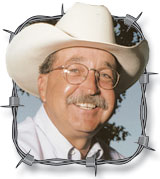The cowboys came last Tuesday to help with my annual fall ritual of sifting through the cow herd. While every cattleman has their own criteria for deciding which cows to keep and which ones to opt out, I’ll grant you that my methodology is not nearly as scientific as most.
After the cows at each farm are gathered into the corral, I have the cowboys turn one or two at a time into a long, narrow run where I am located. I walk amongst them for a couple of minutes evaluating them on attitude (I’m not as mobile as I used to be), to soundness of feet and legs, to the condition of their udder. I also review the records on each cow, which I have downloaded onto my smart phone, to see the ratings on their production history. But… I almost never reject a cow based on her age – a little quirk of mine that did not go unnoticed by one of the cowboys.
“Jerry, I believe there’s a few of those old gals that could have voted in the last election,” one of the guys astutely pointed out. I had to stop the selection process for a few minutes to tell them the story of the second cow I ever owned.
I was 9 years old when I talked my father into letting me buy a registered cow to use as my 4-H project. Since I didn’t have much money, I found a bred cow at a neighboring farm that I thought was a bargain and, if she was a bargain, it was probably because she was three years older than me. The deal was made and I raised a lot of good registered heifers and bulls from her for the next 11 years. The cow raised an excellent calf every year until she died of an apparent heart-attack, at age 23 while I was away at college in 1972. That cow taught me more about the longevity of cattle than any animal husbandry class I ever took.
The experts in agricultural science and research will tell you that the average productive life of a beef cow is seven to nine calves which would make them nine to 11 years in age. On my farm, I even have a name for those kind of cows – ‘the young girls.’ Now, don’t get me wrong, because I don’t have farms full of extremely old cows. As a matter of fact, some of the cows I sorted out last week were younger than 7, but as long as a cow stays in good physical shape, raises a calf every year, and doesn’t try to kill me, she will probably have a home here well into her late teens to mid-20s and is more likely to die of a heart attack or a lightning strike than be sold at the auction.
Next year, I think I’ll even try to schedule my cow sorting for a time when both of my sons can attend and observe my process. As I get closer and closer to that time when they will have to decide whether to let me stay at the house or put me in a ‘home,’ maybe they’ll reach back in their mind and remember that I kept old cows around a long, long time as long as they were productive.






